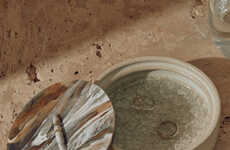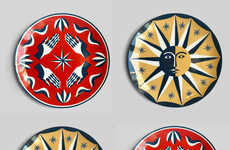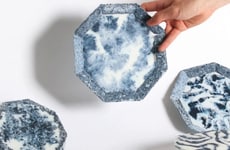
'The Human Trace' Focuses on the Manpower Inherent in Production
Joey Haar — March 29, 2017 — Art & Design
References: dezeen
Though industrial production separates itself from traditional craftsmanship precisely because of its distant from human labor, 'The Human Trace' is a design project that accentuates just how reliant even industrial processes are on human involvement. The project uses a chemical reaction to create deep blue splotches on what would otherwise be pure white porcelain, with the splotches corresponding to the precise places where workers touched the industrially produced tableware.
To create the oceanic markings on the porcelain in The Human Trace, ceramist Arkadiusz Szwed and curator Ewa Klekot had the factory workers wear gloves with fingertips dipped in cobalt blue salts. While handling the tableware, these salts were virtually invisible, but once the porcelain was fired the blues were revealed. The final result is a set of tableware that connects the users more intimately to the production process.
To create the oceanic markings on the porcelain in The Human Trace, ceramist Arkadiusz Szwed and curator Ewa Klekot had the factory workers wear gloves with fingertips dipped in cobalt blue salts. While handling the tableware, these salts were virtually invisible, but once the porcelain was fired the blues were revealed. The final result is a set of tableware that connects the users more intimately to the production process.
Trend Themes
1. Human-centered Production - The Human Trace project demonstrates the value of incorporating human touch and labor into industrial production processes.
2. Craftsmanship in Manufacturing - The use of chemical reactions to create unique markings on tableware highlights the fusion of traditional craftsmanship with industrial production.
3. Enhanced User Connection - Creating tableware that reveals the human touch involved in production fosters a deeper connection between users and the products they use.
Industry Implications
1. Manufacturing - The use of chemical reactions in tableware manufacturing presents an opportunity to incorporate craftsmanship and human involvement into industrial processes.
2. Design - The Human Trace project exemplifies the potential for designers to create products that highlight the human element and enhance user experiences.
3. Consumer Goods - Incorporating visible markings that reflect human labor in tableware manufacturing can differentiate products in the consumer goods industry and appeal to conscious consumers.
2.7
Score
Popularity
Activity
Freshness























